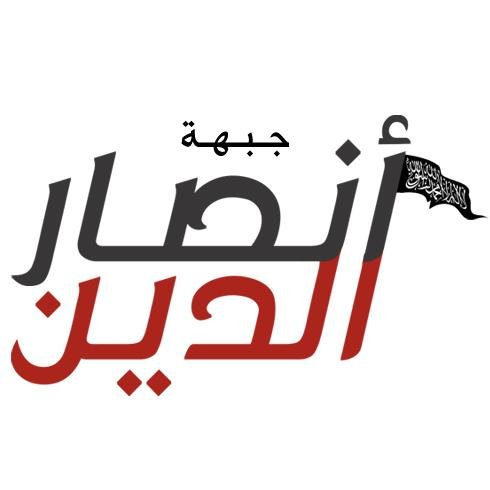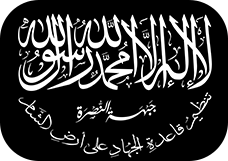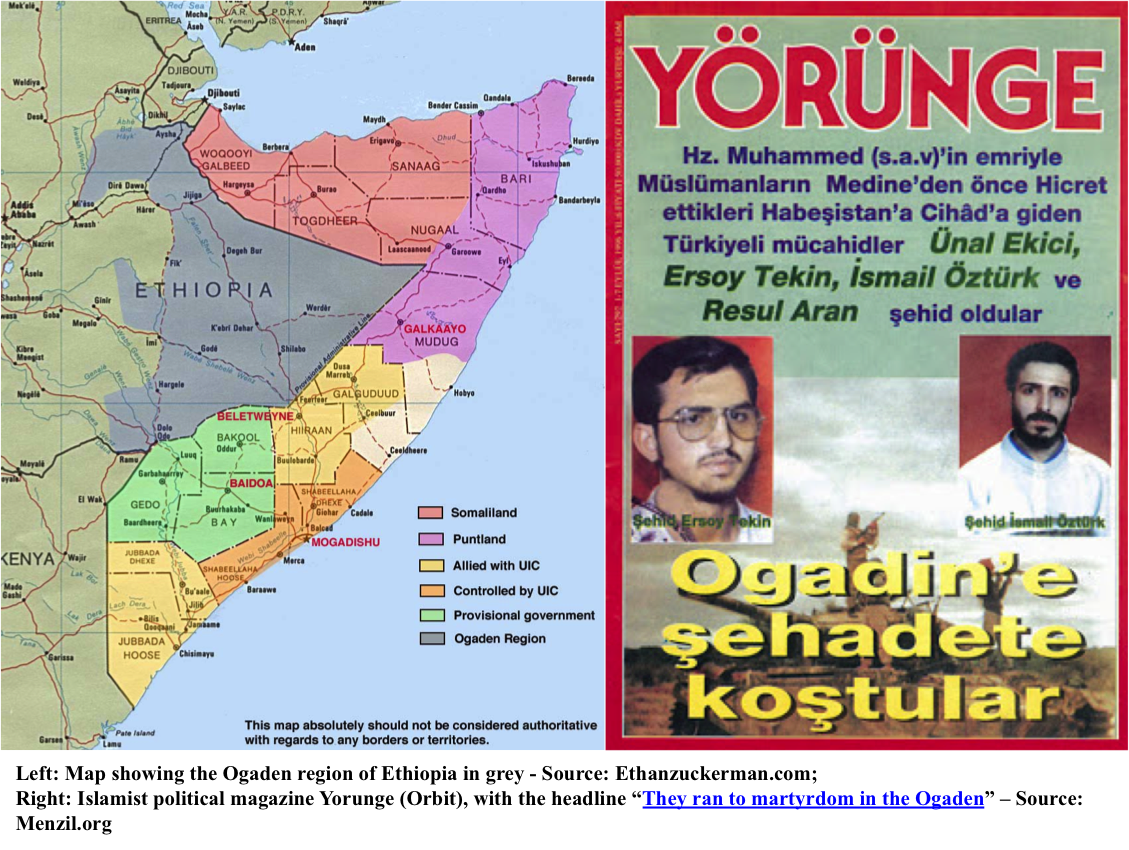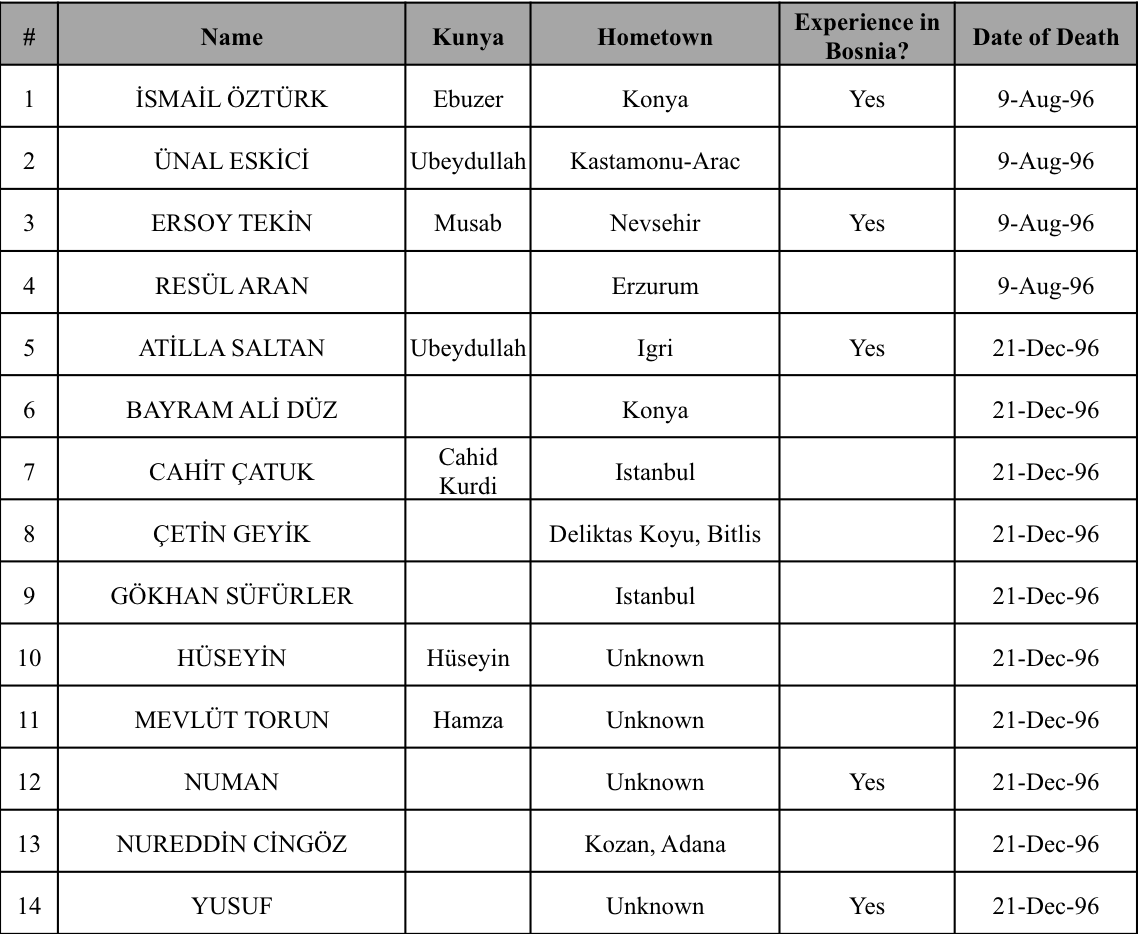North Caucasus Caucus comes on the show to talk about his recent research trip to Turkey. He and Aaron discussed the evolution of Turkish governmental policy towards jihadis, Turks’ role in jihadi groups and IS in Syria and Turkey, Turkey’s arrest campaign against Jabhat al-Nusra and IS, and more.
This episode also features a #SocialMedia segment covering jihadi social media posts from August 17th to August 31st.
We’re working on a special series on the state of Jihadi Studies, and we need some help from listeners. We’ve conducted interviews with many of the top scholars in the field, and we need some people to volunteer to help transcribe the interviews. If you’re interested in helping please email [email protected] Thanks!
The podcast is produced by Karl Morand. If you have feedback you can email [email protected], or find us on Twitter: @JihadPod.
You can subscribe to the show in iTunes or with our RSS feed.
Download this episode (27MB mp3)
Category: Turkey
New video message from The Islamic State: "Message to Turkey – Wilāyat al-Raqqah"

__________________
To inquire about a translation for this video message for a fee email: [email protected]
New fatwā from Jabhat Anṣār al-Dīn: "On the Subject of the Turkish Intervention in Northern Syria"

Click the following link for a safe PDF copy: Jabhat Anṣār al-Dīn — “On the Subject of the Turkish Intervention in Northern Syria”
________________
To inquire about a translation for this statement for a fee email: [email protected]
New statement from Jabhat al-Nuṣrah: "About Recents Events in Rural Northern Aleppo (The Turkish Intervention)"

Click the following link for a safe PDF copy: Jabhat al-Nuṣrah — “About Recents Events in Rural Northern Aleppo (The Turkish Intervention)”
___________________
To inquire about a translation for this statement for a fee email: [email protected]
New article from Shaykh Ḥussayn bin Maḥmūd: "The Turkish Question"
بسم الله الرحمن الرحيم
ليس العجيب أن تنجر تركيا إلى هذه الحرب بعد خسارة حزب أردوغان في الانتخابات وعدم حصوله على الأغلبية التي تمكنه من التفرّد بالسلطة ، وبعد الضغط الأمريكي لسنوات ، وتهديدها له بالأكراد ، فهذا كان متوقعاً ، وقد ذكرناه في مقالة سابقة ، ولكن الغريب أن تصدر الفتاوى من أناس – نحسبهم على خير – يقولون بجواز الدخول تحت الراية التركية لقتال الدولة الإسلامية بحجج واهية ضعيفة تحكي قِصر النظر وقلّة الصبر والجهل بالمآل !!
لو سألك سائل : ما معنى قولهم “ومن المعضلات توضيح الواضحات” ، فإنها هذه المسألة !! إذا كان “الحكم على الشيء فرع عن تصوره” ، فلنتصور المسألة لنعلم حقيقة هذه الفتوى المضحكة المُخجلة :
عندنا دولة تُعلن إسلامها وقادة يُعلنون إسلامهم ويقودون جيشاً يُعلن إسلامه يُقاتل النُّصيرية والنصارى والرافضة والملاحدة دفاعاً عن المسلمين ، وفي المقابل : رئيس يُعلن إيمانه بالمبادئ العلمانية ويعلن علمانية حكومته ويقود جيشاً يُعلن علمانيته وإلحاده وعبوديته لأتاتورك الذي أحل لهم الحرام وحرّم عليهم الحلال فأطاعوه !! لو عندك طفل مسلم يعقل ، اسأله : جيش يعبد أتاتورك ، وجيش يعبد الله ، مع من تكون ؟ إذا كان الطفل الصغير – الذي لم يتجاوز الخامسة – يعرف بفطرته حقيقة هذه المسألة ، فما بال البعض يفسد على المسلمين دينهم !!
العلمانية لمن لا يعرفها : هي “إقامة الحياة بعيداً عن الدين ، أو الفصل الكامل بين الدين والحياة” (مذاهب فكرية معاصرة لمحمد قطب) ، والمعنى الصحيح “للعلمانية” من ترجمتها اللاتينية والانجليزية والفرنسية هي “اللادينية” ، وإنما تُرجمت عندنا بـ “العلمانية” حتى تكون أخف وطئاً على مسامع المسلمين .. قال الشيخ سفر الحوالي : “والتعبير الشائع في الكتب الإسلامية المعاصرة هو “فصل الدين عن الدولة” وهو في الحقيقة لا يعطي المدلول الكامل للعلمانية الذي ينطبق على الأفراد وعلى السلوك الذي قد لا يكون له صلة بالدولة ، ولو قيل : إنها فصل الدين عن الحياة لكان أصوب ، ولذلك فإن المدلول الصحيح للعلمانية : إقامة الحياة على غير الدين ، سواء بالنسبة للأمة أو للفرد” (العلمانية) ، وقال : “إن العلمانية تعني – بداهة – الحكم بغير ما أنزل الله ، فهذا هو معنى قيام الحياة على غير الدين ، ومن ثم فهي -بالبديهة أيضاً- نظام جاهلي لا مكان لمعتقده في دائرة الإسلام ، بل هو كافر بنص القرآن الكريم : {وَمَنْ لَمْ يَحْكُمْ بِمَا أَنْزَلَ اللَّهُ فَأُولَئِكَ هُمُ الْكَافِرُونَ} (المائدة : 44)” (نقلاً عن كتابه : “العلمانية”) وكتاب العلمانية للشيخ سفر – شفاه الله – أجمع وأفضل كتاب كُتب باللغة العربية في هذه النظرية الكفرية الخبيثة ، فليطالع الكتاب من يشك في كفر معتنق العلمانية ، خاصة الفصل الأخير تحت عنوان “حكم العلمانية في الإسلام” (ص 669) ..
فليعلم كل من يحمل السلاح بأن الجهاد لا يكون إلا “ضد الكفار غير المعاهدين ، ولإعلاء كلمة الله” ، فقتال الدولة الإسلامية ليس جهاداً ، والدخول تحت راية علمانية أتاتوركية كافرة ملحدة تأتمر بأمر الصليبيين : ردّة وخروج عن الملة اتفاقاً ، فالمسألة ليست خلافية ، ولا تحتمل الخلاف ، ولا يُتصوَّر فيها الخلاف لمن علم الحال وعلم أقوال علماء السلف في مثل هذه المسألة : قال ابن حزم رحمه الله : “صَّح أن قوله تعالى {وَمَنْ يَتَوَلَّهُمْ مِنْكُمْ فَإِنَّهُ مِنْهُم} إنما هو على ظاهره بأنه كافر من جملة الكفار ، وهذا حق لا يختلف فيه اثنان من المسلمين” ( المحلى : ج11) ، وقال الشيخ حمود بن عقلا الشعيبي رحمه الله : “أما مظاهرة الكفار على المسلمين ومعاونتهم عليهم فهي كفر ناقل عن ملة الإسلام عند كل من يُعتدّ بقوله من علماء الأمة قديما وحديثا” ، وقال الشيخ علي الخضير : “أما مسألة مظاهرة الكفار فأعظم من بحثها هم أئمة الدعوة النجدية رحمهم الله واعتبروا ذلك من الكفر والنفاق والردة والخروج عن الملة ، وهذا هو الحق ، ويدل عليه : الكتاب ، والسنة ، والإجماع” ، وقال الشيخ عبد العزيز بن باز : “وقد أجمع علماء الإسلام على أنَّ مَن ظاهر الكفار على المسلمين وساعدهم بأي نوع من المساعدة فهو كافر مثلهم” (مجموع الفتاوى : ج1) ، فانظر قول الشيخ ابن باز “بأي نوع من أنواع المساعدة” ، وقارنه بمن يريدون من المجاهدين سفك دماء إخوانهم لصالح الصليبيين !!
البعض بلغ من الكذب مكاناً ومن الجهل مبلغاً فقال بأن هذه النازلة من باب “الاستعانة بالكفار” ، وهذا من أعظم الجهل ، فليست نازلتنا هذه من “مسألة الإستعانة” بشيء لأن الراية ليست للمسلمين ، بل الراية صليبية ، والصليبيون هم من يستعينون بالحمقى والمغفلين من أبناء المسلمين وغيرهم ليقاتلوا دونهم ، فأمريكا هي التي استعانت بالرافضة والأكراد الملاحدة والعرب والأتراك ليقاتلوا الدولة الإسلامية ، فالقيادة أمريكية ، والقول قول أمريكا ، والحرب حربها ، والجميع تبع لها ، والأمر لها ، فكيف تكون المسألة استعانة !! أمريكا أرادت تقليل خسائرها في الأرواح فقدّم هؤلاء جنودهم قرابين لها كما كان الكفار يقدّمون القرابين لهُبل .. هل يجهل أحد على وجه الأرض أن أمريكا هي قائدة هذا التحالف الصليبي ضد المجاهدين !! هل يجهل أحد على وجه الأرض أن أمريكا هي التي أقامت هذا التحالف الصليبي !! تحالف صليبي أنشأته دولة صليبية تقوده لحرب المسلمين ، كيف تكون مسألة استعانة !!
إن تفلسف أحدهم وقال بأن تركيا دولة مسلمة ، فنقول : رئيسها يعلن إيمانه بالمبادئ العلمانية ، وحكومتها تُعلن العلمانية ، وجيشها يُعلن حراسته للعلمانية الأتاتوركية ، وقد سُئل الشيخ عبد الله بن عبد اللطيف عن دولة الخلافة العثمانية فقال : “من لم يعرف كفر الدولة ، ولم يفرّق بينهم وبين البغاة من المسلمين لم يعرف معنى لا إله إلا الله ، فإن اعتقد مع ذلك أن الدولة مسلمون ، فهو أشد وأعظم ، وهذا هو الشك في كفر من كفر بالله وأشرك به ؛ ومن جرّهم وأعانهم على المسلمين بأي إعانة فهي ردة صريحة” (الدرر السنية 10/429) ، هذا في زمن الخلافة ، والأتراك كانوا يُعلنون الإسلام آن ذاك مع وقوعهم في بعض الشركيات ، فكيف بالجيش الذي يُعلن علمانيته وأتاتوركيته مع بقاء الشركيات التي كفّرهم من أجلها العلماء !!
قد يقول البعض : أردوغان له مواقف محمودة في نصرة بعض قضايا الأمة ، فنقول : “أبو طالب بن عبد المطّلب” كانت له مواقف أعظم بكثير في نصرة رسول الله صلى الله عليه وسلم ، ولما لم يُعلن إسلامه وأعلن بقائه على دين عبد المطلب : كان في النار مع الكفار .. أبو طالب عم النبي صلى الله عليه وسلم ، وقد كفل رسول الله صلى الله
New statement from Majlis Shūrā Ahl al 'Ilm in al-Shām: "On Cooperation and Coordination with the Turks in Repelling The Islamic State and the PKK"
Click the following link for a safe PDF copy: Majlis Shūrā Ahl al ‘Ilm in al-Shām — “On Cooperation and Coordination with the Turks in Repelling The Islamic State and the PKK”
__________________
To inquire about a translation for this statement for a fee email: [email protected]
al-Ḥayāt Media Center presents a new magazine issue from The Islamic State: “Constantinople #2"
Click here for the first issue.
—

Click the following link for a safe PDF copy: The Islamic State — “Constantinople Magazine #2″
_________________
To inquire about a translation for this magazine issue for a fee email: [email protected]
GUEST POST: The Conquest of Constantinople: The Islamic State Targets a Turkish Audience
NOTE: As with all guest posts, the opinions expressed below are those of the guest author and they do not necessarily represent the views of this blogs administrator and does not at all represent his employer at the Washington Institute for Near East Policy.
Jihadology.net aims to not only provide primary sources for researchers and occasional analysis of them, but also to allow other young and upcoming students as well as established academics or policy wonks to contribute original analysis on issues related to jihadism. If you would like to contribute a piece, please email your idea/post to azelin [at] jihadology [dot] net.
Click here to see an archive of all guest posts.
—
The Conquest of Constantinople: The Islamic State Targets a Turkish Audience
By North Caucasus Caucus
“We earnestly desire from our exalted god that He grant us the good news of the conquest of Istanbul and other places, and in that vein we patiently continue.” – Konstantiniyye, June 2015, pp.6
Introduction

On 01 June 2015, official Islamic State (IS) media outlet al-Hayat Media released the first issue of a new Turkish language magazine entitled, Konstantiniyye (the transliteration of the Ottoman spelling of Constantinople). The lay out and design of the 46-page magazine are familiar to those who have read some of al-Hayat’s other publications such as Dabiq and Istok, a similar specifically Russian-language magazine just released several weeks prior to Konstantiniyye. While all the previous issues of IS’s magazine, Dabiq, had been translated into Turkish, this is the first official publication from al-Hayat directed at a Turkish audience and could be an indication of IS leadership no longer caring as much about provoking the Turkish government.
Content and Themes Directed at a Turkish Audience
The first issue of Konstantiniyye was entitled, “The Conquest of Constantinople.” In the introduction of the magazine, al-Hayat lays out its goals and bemoans that “the people of Turkey, especially Muslims, have been deprived of much of the multitude of news, writings, and videos coming out of the Islamic State each day.” To rectify this, al-Hayat states that they established a dedicated Turkey desk, which will provide official translations of all al-Hayat publications as well as publish Konstantiniyye monthly. Konstantiniyye specifically for a Turkish audience and focusing on “topics of interest to Muslims in Turkey about the Islamic State.” The writers go on to say, “We have tried not to overwhelm the reader by taking care to keep our writings short.” The release of the magazine appears to have been timed to coincide with two events in Turkey – the annual celebration of the conquest of Constantinople and the Turkish national elections.
Conquest of Istanbul
The centerpiece of the magazine is an article entitled, “The Conquest of Constantinople.” The magazine was released two days after Turkey’s annual celebration of “Fetih Gunu,” the day commemorating the fall of Constantinople to the Ottomans in 1453. The commemoration of this event has grown considerably over the last decade and become a much more prominent event in Turkish popular consciousness. The impressive panorama museum, constructed in 2006, remains a very popular tourist attraction. (I visited myself in 2014 and had to wait in line for more than 45 minutes to enter). A film about the conquest, Fetih 1453 was released in February 2012 and was the most expensive and highest grossing movie in Turkish history. Clips from Fetih 1453 were used in the al-Hayat Balkans-focused release, “Honor in Jihad.”
The article seeks to tie the conquest of Constantinople and modern day Istanbul into IS’s broader narrative about the pre-destined nature of Caliphate and the final apocalyptic battles at al-Amaq and Dabiq. Based primarily on the hadiths of Abu Hurairah, the author writes, “Allah’s messenger [Muhammed]…told us the good news that Constantinople would also be conquered. Constantinople was conquered before, but the conquest referred to in this good news has not yet occurred.” However, the conquest does not refer to taking the city by force. The author writes, “As can be understood from these hadiths, close to the Last Hour, the city that was formerly known as Constantinople and now is known as Istanbul will be conquered with the call of takbir and without weapons or blood.” The discussion of the conquest of Istanbul is likely in line with previous claims that IS will conquer Rome. This is not an actual goal, but more to energize a potential Turkish audience.
Following “The Conquest of Constantinople,” the magazine features a poem about Istanbul (a full translation of the poem can be found at the end of this article). The popularity of poetry among jihadis has been well chronicled among many nationalities of foreign fighters (Thomas Hegghammer has written on this topic extensively, as has The New Yorker). This mirrors the increased volume of original IS-focused nasheeds regularly released throughout the last few months.
Elections and Democracy

There ar e two sections on democracy, one entitled, “Democracy was Ignited ” and the other “The Qur’an is for the Dead and Democracy is for the Living.” Both articles lay out standard Salafi arguments about the incompatibility of being a Muslim and participating in democratic systems, as well as how the democratic systems will ultimately fall just like communism and socialism. As a potential indicator of writers knowing their audience, the first article included a meme popular on more religiously conservative Turkish Facebook pages, featuring US soldiers raiding a house in Iraq with the caption, “Open the door, Democracy is coming!” The title of the second article presents the idea that some Muslims have been deceived into believing that the Qur’an does not apply to them in their everyday life, therefore there is a need for democracy.
While unlikely coordinated, a Turkish Salafi group headed by Halis Bayancuk (Ebu Hanzala), similarly launched an anti-voting campaign. Though often associated with IS in both the Turkish and Western media, Bayancuk publicly stated in May 2015 that he has not pledged allegiance to IS emir Baghdadi, but some IS members call him their brother and he calls some IS members his brothers in religion. Using the slogan, “Don’t vote, honor your creator,” Bayancuk’s websites, Tevhidgundem, Tevhiddersleri, and Tevhiddergisi, laid out the organization’s strategy and goals. Laying out both real world and virtual tactics, goals included distributing hundreds of thousands of brochures and hanging a similar number of billets in 30 major cities around the country as well as sending five million e-mails and hashtag bombing (having supporters all tweeting at 9pm local time in order to get the campaign’s hashtags trending). On 04 June, #OyKullanmaYaratıcınaŞirkKoşma (Don’t vote, don’t undermine your creator) and #OyKullanmaRabbineSirkKosma (Don’t vote, don’t undermine your lord) did briefly trend in Turkey. Under the hashtag, supporters posted photos of themselves posting billets and using graffiti stencils to deface political advertisements throughout the country.
Considering the enviable over 85% turnout for the election, the campaign likely had a negligible effect on the overall outcome of the election. However, it shows a growing coordination and support base for Salafi groups. A similar, but much smaller campaign was launched during the last national election in 2011. One major difference was the attempt to get grass roots support – providing instructions on how people could personally get involved as well as PDFs of the brochures and stickers so supporters could have them produced in one of Turkey’s ubiquitous print shops.
Other Turkey Focused Content and Other Standard IS Propaganda

The final two articles, calibrated to resonate specifically with a Turkish audience, are a dietary fatwa and an article about Palestinians in the Yarmouk camp. The fatwa focuses on how people living in the Islamic State should not eat meat brought in from Turkey (such as pre-packaged meat sold in grocery stores). The primary reason against eating this meat, according to the fatwa, is the animals are not slaughtered in accordance with proper rules and those handling the meat are not actually Muslims. Stories about processed meat in Turkey not being halal have existed for years (though the authors claim they have insider information on the topic). Additionally Palestinian issues have had great resonance among a large portion of the Turkish population, not just Salafis or the very religiously conservative.
The remainder of the magazine is standard IS media material – a translation of an address by IS spokesman Ebu Muhammed al Adnani entitled, “The Killers and Those who are Killed (originally released in March 2015), justification for the destruction of Iraqi antiquities, and a profile of Boko Haram and its pledge of allegiance to IS. The material is generally short and punchy and with the purpose of convincing readers the necessity to immigrate to the Islamic State.
Distribution and Reach
The website, darulhilafe.com appears to have been the first to post the
The Clear Banner: Turkish Foreign Fighters and the Ogaden
The Clear Banner sub-blog on Jihadology.net is primarily focused on Sunni foreign fighting. It does not have to just be related to the phenomenon in Syria. It can also cover any location that contains Sunni foreign fighters. If you are interested in writing on this subject please email me at azelin [at] jihadology [dot] net.
—
Turkish Foreign Fighters and the Ogaden
By OSMahmood and North Caucasus Caucus
In recent months, there has been a major increase in international media coverage of Turkish citizens fighting alongside The Islamic State (IS). Much of the commentary has focused on the notion that this is abnormal behavior for citizens of the secular state. While this is partially true (the percentage of Turks in IS is even lower than some European countries by comparisons of percentage of total population), it should be recognized that at least for certain communities in Turkey, participating in jihadist conflicts is not abnormal, and those who participate are often honored. To provide a vivid example of this trend, this article will focus on a very specific case from 1996 of 14 Turkish foreign fighters who were killed in one of the lesser-known jihadi conflicts.

Conflict in the Ogaden
The year 1996 must have been a confusing time to be an aspiring jihadi. With the Dayton Accords ending the war in Bosnia the previous year, and the Khasavyurt Agreement temporarily halting hostilities in Chechnya, two of the premiere jihadist conflicts enticing foreign fighters came to an end. Given this context, some jihadis, including a group of young Turkish citizens, looked further afield to participate in one of the more obscure Islamist conflicts – the battle between ethnic Muslim Somalis and Ethiopian government forces in the Ogaden region of Ethiopia.
The Ogaden – A Basic Background
The Ogaden, consisting of the mainly ethnic Somali-inhabited eastern region of Ethiopia, has long had a contentious history. By the early 20th century, the region slowly came under the domain of the Christian empire based in the highlands of central Ethiopia, though control shifted to the British after the Second World War. The British returned the Ogaden to Ethiopia in 1948, along with the Haud in 1954 (the north-eastern section used as a grazing land by nomadic Somali herders), effectively signaling the demise of a ‘Greater Somalia’ that united all Somali-inhabited lands, much to the chagrin of many Somali nationalists.
The reincorporation of the Ogaden into Ethiopia sparked a host of resistance movements and a devastating Cold War-infused proxy battle with Somalia in 1977-78. Following the collapse of the Mengistu government in Ethiopia in 1991, the Ogaden National Liberation Front (ONLF) assumed control of the region under Ethiopia’s federal structure. The harmonious relationship between the ONLF and the new Ethiopian government, however, did not last – by 1994 the ONLF had divided, with a wing renouncing its political position in favor of armed resistance.
The Rise and Fall of Islamist Interest in the Ogaden
During this time, the struggle for the Ogaden caught the eye of Islamist actors in Somalia. While the ONLF operated as a secular, nationalist party within Ethiopia, often accused of narrowly representing the Ogaden clan, al-Ittihaad al-Islami (AIAI) in Somalia developed a branch focused on the Ogaden that infused Somali irredentism with Islamist rhetoric, adding a new, albeit somewhat peripheral dimension to the struggle. The conflict was often portrayed in terms of Somali Muslims rising up against a Christian entity. Based in Luuq along the Ethiopian-Somali border, AIAI’s Ogaden wing also established training camps within the Ogaden itself, and even conducted a series of attacks in Ethiopia’s two largest cities in 1995-6.
Osama bin Laden also developed an interest in the Ogaden during his stay in Sudan from 1992-96, so much so that during his August 1996 declaration of jihad against the United States, the al Qa’ida (AQ) leader referenced the region amongst a host of other global hotspots where Muslims have suffered at the hands of a “Judeo-Christian alliance.” Representatives from al Qa’ida traveled to the Ogaden in the early 1990s and aided in the establishment of training camps, with bin Laden himself reportedly investing $3 million to bring foreign fighters to the region, cementing the Ogaden on AQ’s early 1990s horizon [Note: The vast majority of open-source information regarding AQ activities in the Ogaden during this time period comes from declassified documents in the Harmony Database, obtained by the Combating Terrorism Center and analyzed in its 2007 report Al-Qaida’s (Mis)Adventures in the Horn of Africa].
Ethiopia, however, responded forcefully to the 1995-6 attacks, bombing camps in Luuq on 9 August 1996 and again in January 1997, effectively routing AIAI. Combined with Osama bin Laden’s move to Afghanistan and AQ’s struggles in Somalia, the Ogaden likely fell off AQ’s map. With AIAI decimated, resistance to Ethiopian rule returned to the realm of the secular, clan-based ONLF, a stiutation that largely persists to the present day.
Turkish Involvement in the Ogaden
Much of the information for this article was drawn from Turkish language sites dedicated to Turkish Islamist martyrs killed in conflicts outside Turkey (as well as those killed fighting Kurdish separatists), such as sehidlerimiz.com and menzil.org. These websites purport to reproduce contemporary reporting from the time of the fighters’ deaths and often provide images of the news articles, primarily from local newspapers. Due to the age and second hand nature of much of this material, some caveats apply, especially as data on Turkish fighters who may have gone to fight but ultimately survived is not available.
As in Syria, looking into the backgrounds of fighters reveals connections to other jihadist conflicts and/or friends and family serving as pulling factors. Below we will describe the experience of a number of the Turkish fighters – who likely joined with the Islamist AIAI’s Ogaden wing, and were all reportedly killed along the Ethiopian-Somali border on two different days between August and December 1996.

Backgrounds and Parental Involvement
From the available information, the majority of the 14 Turkish fighters killed in Ogaden had similar backgrounds – early 20s, often college students or professionals, and idealistic. One fighter, Nureddin Cingöz from Kozan, Adana, had graduated from a theological imam-hatip high school, where he allegedly won first place in a hadith knowledge competition. However, when he left with his friend, Bayram Ali Düz, for the Ogaden, both were students at Konya’s Selcuk University.

In some cases, fighters seemed to travel without support from their families. For example, Gökhan Süfürler graduated from a vocational high school in Istanbul before taking a job as an accountant working at a company in Kartal. After he left his job, Süfürler’s father wanted him to work at a different job before completing his military service, but Süfürler “claimed to have higher ideals,” according to his father. According to a letter he sent home, Süfürler wrote that he felt guilty living a good life in Turkey while injustice and deprivation occurred elsewhere. In an interview with Selam Gazetesi, Sufurler’s father explained that while he was born in Istanbul, his family was originally from Salonica, Greece and was quite secular. However, his father and other family members started praying more regularly after his son’s death.
In other cases, families appear to have been supportive. In an interview after his death in the Ogaden, Ismail Ozturk’s father stated that his son’s death should not be treated as a tragedy, but as martyrdom. Ozturk’s father went on to say that when his sons were young he brought back Islamic books from Libya where he was working, and that he tried to pass on his religious convictions. Ismail took his upbringing to heart and went to Bosnia, but the war ended two or three weeks after his arrival. He returned to Turkey changed and even more committed to jihad. He later tried to join the conflict in Chechnya, but was turned back by Russian preventative measures. After these failures, Ozturk decided try his luck in the Ogaden. This time, however, his father allegedly tried to convince him to stay and get married, demonstrating the at times shifting nature of familial support for such activities.
The Bosnian Connection
The conflict in Bosnia appears to have served as a central bridge to the Ogaden, with many fighters meeting there and deciding their next destination. One figure who seems to be especially important as a link between Bosnia and the Ogaden is Atilla Saltan. A young man from Agri in eastern Turkey, Atilla eventually got a job in advertising in Istanbul. While there, he became engaged in the study of the Quran and other religious activites, eventually leaving his job. He moved to Germany, staying with family and decorating a local mosque. His apparent motivation was to make his way to Bosnia to fight, arriving there in November 1995. When the ceasefire came into effect on 14 December 1995, however,
The Clairvoyant: Turks Or Uyghurs Arrested In Indonesia?
Earlier this week, reports surfaced that four Turks had been arrested in Poso, Indonesia related to links with the Islamic State. It was later revealed though that in fact they were Uyghurs from Xinjiang, China. Why the confusion? There is actually a relatively simple answer to this, which was recently provided by a jihadi online that also helps us better understand some of the processes for how individuals are making their way toward Syria.
According to an individual that uses the name Abdullah Abu Bakr, Uyghurs have a difficult time obtaining Chinese passports to travel abroad. I personally cannot attest or know the veracity of this claim since I do not follow Chinese policies on this issue closely. That said, if one takes it as stated, because of this, these wannabe Uyghur foreign fighters then create fake passports, specifically from Turkey. He then claims they venture to Malaysia or Thailand where they might spend some time in prison, but afterwards because they were caught with these fake Turkish passports they are then deported to Turkey. Once in Turkey, according to him, Turkish officials view the Uyghurs as Turkic peoples and therefore allow them to safely stay in Turkey, which then allows the Uyghurs to safely get into Syria. This again raises questions about Turkish potential in enabling of the foreign fighter flow into Syria. He then warns that if any of this process gets snuffed out then the individuals attempting to fight jihad in Syria (and/or Iraq) will get sent back to China and face prison there. In part, this is likely why Indonesia at first believed the individuals arrested were from Turkey.
Of course, he does not mention Indonesia, but I do not see why this process couldn’t have played out there as well, whereby individuals from Xinjiang using fake Turkish passports traversed to Indonesia. Once there, the hope being to be deported then to Turkey so they can make easy entrance into Syria. This illustrates not only the efforts that go into trying to get to Syria, but also highlights that there is a network of individuals that has created a system to try and get individuals over there even if the process might take some time, arduous, and risky. It also likely shows that there are more interlinked connections between the different jihadi facilitation networks in south/southeast Asia as well as how they then connect back to the facilitation networks based in Turkey and/or the Arab world.
What the Syrian conflict has done is regenerate old networks, connect separate past networks that now overlap, and the creation of new ones that are now part of the broader echo system related to global jihadism. These connections created for going to join up to fight in Syria/Iraq will also be important for any potential returnees and/or the use of external operations if it is in the cards either for the Islamic State or al-Qaeda’s branch Jabhat al-Nusra. All of this just highlights that there is a very sophisticated methodology for ways in which individuals not so close to Syria get there that helps not only those that want to get there, but cements key relations that could be relevant to future jihad in south/southeast Asian countries.
